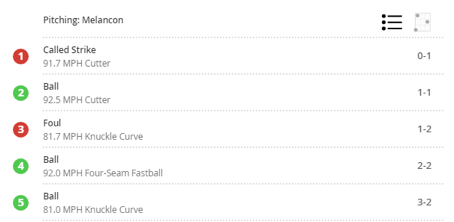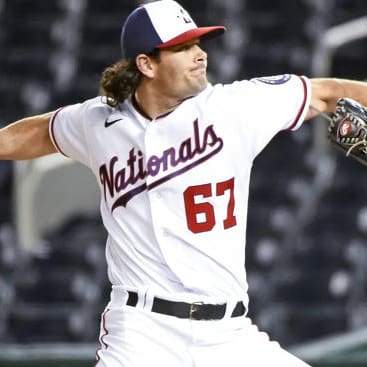This article is part of our The Saber's Edge series.
On the last day of the season, I was flipping through MLB's Gameday following every single at-bat on my and my opponent's Tout Wars team. We were in a tight race in the on-base percentage (OBP) category.In the second to last remaining game (neither one of us had a hitter in the other game), Christian Yelich came to bat. If he gets on base, I hold on and win OBP. If he gets out, I lose. So I am sitting there suffering knowing that the odds were stacked against especially with Mark Melancon on the mound. The at bat start with:

At one point the count was 2-1, but end up going 3-2 until the greatest four Gameday words came across the screen, In Play, No Out(s).

I won OBP .318 to .317. I have never had a league title come down to the final at-bat. Most times, the title is out of play on the last day. Truthfully, it was exhausting.
Here are a few points I took away from the season.
Understand how any unique categories will play out.
This was the first year for this league with a unique set of rules. It was mainly a head-to-head (H2H) league with a small roto component thrown in. The key changes from the norm were:
• Net Saves
• Net Stolen Bases
• On-Base Percentage (OBP) vs. Batting Average (AVG)
• Wins + Quality Starts
• K/9 vs K
I did some research on Net Saves and Net Stolen bases and found no advantage to be gained there. There wasn't much of a difference in projected overall value and success rate. With OBP, I have seen players with high OBP (high walk guys) compared to their AVG get undervalued. I went through the players and marked those with the biggest difference and hoped to grab some. I had no luck with this theory as my opponents had similar valuations.
The one factor I was able to take full advantage of was K/9. With a league minimum innings pitched at 950, I would be able to run four high-quality starters and five lockdown bullpen arms. In the draft, I wanted to get two of the top few starters and then piece together the rest of my pitchers.
The plan worked perfectly as I was able to pick up Max Scherzer and Jose Fernandez. With those two, along with some great setup men, I won the K/9, WHIP and ERA stats almost every week and be competitive in saves.
With this strategy, I had to accept punting wins and quality starts. I figured some other teams would follow with my strategy, but they didn't initially. As the season went on, more teams dropped their starters for relievers and I was able to finish in the middle of the wins and quality starts in the season's second half.
Be adaptable and/or prepared to variables
I totally expected the other participants to attack the league rules and go with a higher number of relief pitchers with the chance one owner would go with just relief pitchers. I created my pitcher evaluations and went to the auction all prepared. That was until Michael Wacha was nominated early on and went for $11. Crap. Wacha was not on my auction list.
I didn't really have an issue with Wacha going too high, but to go with my four-starting-pitcher plan, I would need some more pitchers to acquire than I had prepared to take. I quickly picked up Scherzer and Fernandez each at $10 under my projected values for them, but I would need to get some starting pitchers and my lower valued guys were going at too high a cost. There wasn't time during the auction to research as the pace is incredible, but I got a break when someone suggested a bathroom break. I spent almost the whole break coming up with a list of pitchers on whom to bid. I did OK by picking up Kyle Hendricks (which I stupidly dropped) and Yordano Ventura.
The biggest change I would make is to find out immediately where the starting pitcher market stands and then have possibly three to five player evaluations based on different bidding scenarios, in this case, the starting and relief pitcher mix. I would probably throw out what I think is a $2 to $3 pitcher and see where the bidding goes. If he goes for $11, I would assume more owners are going for starting pitchers and I can use those evaluations. If all I get is crickets, I know the other owners are going for more relief pitchers.
Find out how owners value limited resources
I tried to find out immediately how teams are going to value saves and stolen bases. In an auction, it is much easier than a draft, but it can be done. In an auction, I like to put out the sixth to eighth best closer I am not fond of owning with a low price. I know my dollar value and will not look at my value sheet again. Instead, I am watching the room as the bidding happens. The biggest tell I am looking for is owners completely not in the bidding process. I want to know who in the room is dumping saves.
During the auction, I could not pick anyone out, so I knew everyone was interested in a closer, but the values were low. I wasn't surprised with the high starters' values. Kenley Jansen went for $25. Wade Davis for $20. Then the prices dropped like a rock — $13 for Chapman, $9 for Britton. I nabbed Will Smith (pre-injury) for $6 and Roberto Osuna for $2.
The focus needs to stay the same on drafts and online auctions. In drafts, I like to see where the stolen base-only guys get taken. Is his value more or less than their ADP and/or my values? In an online auction, get ready for some cut-and-paste. Most websites show who bids on each player. Keep track of these in owners and it can give an insight on who bidding on these players or not.
Stick with your evaluations
From now until the next year's draft, an owner starts to assemble his player information. I usually keep a spreadsheet going for the players I examine. I usually keep this sheet available until projection systems like Steamer and ZIPs come out and I compare. I make any changes and then really start looking for playing time changes during spring training. With these projections, I create values using the SGP method outlined in Larry Schechter's book, Winning Fantasy Baseball.
Following this method, it allows me to not overbid and waste precious dollars in the auction. I know the player's value. I have worked on it for months and now I try to bid at or less than these values. I completely understand there may be some inflation with the top players and I take this into account. The key is to pretty much ignore the name and go with stats. If you like a player more, raise their stats to your projected value, and stick the final value. You may not end up with these players as others may like them more. The key to winning is to create a production surplus.
In this draft, I got all my hitters at or below my auction values except Jason Heyward and my catchers. I had to pay a couple extra dollars for them or I was going to leave some money on the table. Additionally, my hitters were old and boring so I could see why others didn't like them, but I was getting good values. Generally, it seemed everyone had similar values, but I was able to pick of the following players under cost:
Brian Dozier: $20, $15
Christian Yelich: $15, $10
Dustin Pedroia: $6, $2
Mark Trumbo: $4, $2
None of those names were highly sought after going into the season, but they were able to give me some nice surplus value.
Picking rookies to target
In late July, I had a choice to make. My team had the injury bug and two highly touted prospects were getting the call, Alex Bregman and David Dahl. A lot of hype surrounded Bregman's fast rise, but Dahl was no slouch. I implemented my simple rule when deciding on which prospects to target. I take their batting, hitting and speed grades from Baseball America and/or MLB.com and get a composite grade using the following formula:
Prospect's fantasy value = Hitting Grade * 2 + Power Grade * 2 + Speed Grade
The following formula is missing the defensive component, which is helpful to see who gets to the majors, but once in the show, fantasy owners only have to worry about the league's worst defenders moving to a new position.
Using the above formula and Baseball America's and MLB.com's grades for the pair, here are their values:
| PLAYER | PUBLICATION | HITTING | POWER | SPEED | TOTAL |
| Alex Bregman | MLB | 60 | 50 | 50 | 270 |
| Alex Bregman | BA | 60 | 45 | 55 | 265 |
| David Dahl | MLB | 55 | 50 | 60 | 270 |
| David Dahl | BA | 60 | 55 | 60 | 290 |
While they were even in their MLB.com grades, Dahl graded out higher with their Baseball America grades. I decided to throw my FAAB money and Dahl and ended up with the better fantasy contributor with three more steals and 50 more points in batting average.
As for pitchers, these are a tougher group to evaluate. With rookie pitchers, I aim for as many of these three items as possible.
• Good control with a BB/9 less than 3.0 in Triple-A or the majors. This is No. 1, as a rookie walking a ton of batters won't be helpful.
• Hopefully, three average or better pitches. A pitcher with two pitches usually doesn't make the cut as a starter.
• Watch a start, hopefully the debut, with the home announcers. I don't know how many times a watching a start, I get good information on how the pitcher has changed since their early season scouting reports. They may have added a pitch or increased their fastball velocity. Get you own scouting report.
Know your waiver wire
My biggest failing in the league was not making enough moves on the waiver wire, especially for hitters. I churned and burned for pitchers as I started the season off rough, but I generally stayed with the same hitters. Every week I looked at my players and thought … that will do. In every other league, I am in, the lineup would work. In this league, there were more decent batters available so I should have been looking for replacements when players were obviously struggling.
I was playing a broke Jason Heyward too much with Rajai Davis (12 HR, 43 SB) on the waiver wire for weeks. I don't believe in making moves for the sake of making moves. In the shallower leagues, though, I need to be concentrating on working the waiver to make any possible positive move.
Conclusion
It was great to be invited to participate in Tout Wars and I will be grateful to those who let me join. I completely understand I would have been the runner-up depending on one single at-bat, but that is one of the reasons we compete.
The main idea I keep working on is not resting on my previous accomplishments. There is talk of the league setup coming back, so I expect any gains I had to disappear, and I will need to make fewer mistakes. I already can't wait for next season.












